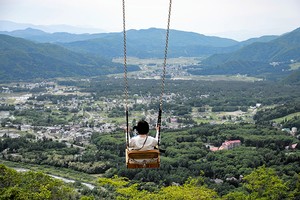By LISA VOGT/ Special to Asahi Weekly
January 16, 2024 at 07:30 JST
 Himeji Castle, unlike many other Japanese castles, was never destroyed in wars, earthquakes or fires and survives in its original form. It is known as White Heron Castle due to its elegant, white appearance. The castle grounds are divided into an inner walled zone and an outer walled zone surrounded by a double moat. (Photo by Lisa Vogt)
Himeji Castle, unlike many other Japanese castles, was never destroyed in wars, earthquakes or fires and survives in its original form. It is known as White Heron Castle due to its elegant, white appearance. The castle grounds are divided into an inner walled zone and an outer walled zone surrounded by a double moat. (Photo by Lisa Vogt)
If you’re well prepared, there is nothing to fear,” the saying goes.
The men, I’m assuming men, who drew up the blueprints to Himeji Castle thought of everything. History records the names of the bigwigs who commissioned great historical structures. But the identity of the people who labored putting pen to paper and drafting the details is consigned to oblivion. How unfair!
In 1333, Akamatsu Norimura, a guardian of Harima province, built a fort to protect the western side of Kyoto, and in 1346, his son rebuilt the first structure of what would become Himeji Castle. Over the centuries, the castle changed hands and was remodeled and expanded many times.
Each owner and other influential people, such as the Ikeda, Kinoshita, Sakai and Matsudaira families, left a mark on the castle, such as family crests on roof tiles. A gable of a gate is adorned with a cross attributed to Kuroda Kanbei (1546-1604), a feudal lord who once converted to Christianity in 1585 before Christians were persecuted.
The castle is known nationwide as White Heron Castle because of its white-plaster facade made from slaked lime, seaweed extracts and crushed white stones.
The magnificent superstructure is a marvel of defensive architecture with two moats (three previously existed), five kilometers of fortified walls and stone walls more than 20 meters high. The castle has square, circular and triangular loopholes from which defenders with firearms or bows and arrows could attack would-be intruders.
With angled chutes whereby rocks and hot oil could be poured from above onto the attackers below, hiding places where defenders could lie low until the moment was suitable for a surprise attack, racks full of weapons lining just about every interior wall of the castle, confusing mazes of gates and baileys that consist of psychological twists where intruders lost their bearings and questioned whether they were entering or leaving the castle, the castle is impregnable.
Indeed, the nameless designers and engineers left no stone unturned and were ready for anything. Because of this, or not, we’ll never know; the castle has never been attacked.
To anyone considering visiting the castle and making it up to the top, be forewarned that there are more than a hundred steep steps. If you’re not in shape and have a Stairmaster, rev it up and start training. And unless you have an exhibitionist streak, avoid miniskirts because going up the steps will reveal more than you may want.
Himeji Castle’s graceful form and tactical function are peerless.
* * *
This article by Lisa Vogt, a Washington-born and Tokyo-based photographer, originally appeared in the Nov. 5 issue of Asahi Weekly. It is part of the series "Lisa’s UNESCO World Heritage Sites in Japan," which depicts various parts of the country through the perspective of the author, a professor at Aoyama Gakuin University.




















A peek through the music industry’s curtain at the producers who harnessed social media to help their idols go global.
A series based on diplomatic documents declassified by Japan’s Foreign Ministry
Here is a collection of first-hand accounts by “hibakusha” atomic bomb survivors.
Cooking experts, chefs and others involved in the field of food introduce their special recipes intertwined with their paths in life.
A series about Japanese-Americans and their memories of World War II